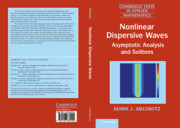Book contents
- Frontmatter
- Contents
- Preface
- Acknowledgements
- PART I FUNDAMENTALS AND BASIC APPLICATIONS
- 1 Introduction
- 2 Linear and nonlinear wave equations
- 3 Asymptotic analysis of wave equations: Properties and analysis of Fourier-type integrals
- 4 Perturbation analysis
- 5 Water waves and KdV-type equations
- 6 Nonlinear Schrödinger models and water waves
- 7 Nonlinear Schrödinger models in nonlinear optics
- PART II INTEGRABILITY AND SOLITONS
- PART III APPLICATIONS OF NONLINEAR WAVES IN OPTICS
- References
- Index
1 - Introduction
Published online by Cambridge University Press: 05 June 2012
- Frontmatter
- Contents
- Preface
- Acknowledgements
- PART I FUNDAMENTALS AND BASIC APPLICATIONS
- 1 Introduction
- 2 Linear and nonlinear wave equations
- 3 Asymptotic analysis of wave equations: Properties and analysis of Fourier-type integrals
- 4 Perturbation analysis
- 5 Water waves and KdV-type equations
- 6 Nonlinear Schrödinger models and water waves
- 7 Nonlinear Schrödinger models in nonlinear optics
- PART II INTEGRABILITY AND SOLITONS
- PART III APPLICATIONS OF NONLINEAR WAVES IN OPTICS
- References
- Index
Summary
In 1955 Fermi, Pasta and Ulam (FPU) (Fermi et al., 1955) and Tsingou (see Douxois, 2008) undertook a numerical study of a one-dimensional anharmonic (nonlinear) lattice. They thought that due to the nonlinear coupling, any smooth initial state would eventually lead to an equipartition of energy, i.e., a smooth state would eventually lead to a state whose harmonics would have equal energies. In fact, they did not see this in their calculations. What they found is that the solution nearly recurred and the energy remained in the lower modes.
To quote them (Fermi et al., 1955):
The results of our computations show features which were, from beginning to end, surprising to us. Instead of a gradual, continuous flow of energy from the first mode to the higher modes, … the energy is exchanged, essentially, among only a few. … There seems to be little if any tendency toward equipartition of energy among all the degrees of freedom at a given time. In other words, the systems certainly do not show mixing.
Their model consisted of a nonlinear spring–mass system (see Figure 1.1) with the force law: F(Δ) = –k(Δ+α Δ2), where Δ is the displacement between the masses, k > 0 is constant, and α is the nonlinear coefficient.
Information
- Type
- Chapter
- Information
- Nonlinear Dispersive WavesAsymptotic Analysis and Solitons, pp. 3 - 16Publisher: Cambridge University PressPrint publication year: 2011
